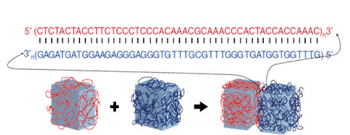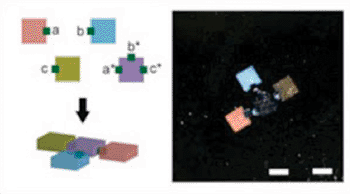Programmable Glue Comprised of “DNA Bricks” Used to Regenerate Damaged Organs, Construct Human Tissues
By LabMedica International staff writers
Posted on 26 Sep 2013
A team of US scientists has found a way to self-assemble complex structures out of bricks smaller than a grain of salt. The self-assembly technology could help resolve one of the major challenges in tissue engineering: regrowing human tissue by injecting tiny snippets into the body that then self-assemble into larger, intricately structured, biocompatible scaffolds at an injury site.Posted on 26 Sep 2013
The key to the self-assembly process was developing the world’s first programmable glue. The glue is comprised of DNA, and it directs specific bricks of a water-filled gel to stick only to each other, the scientists reported in the September 9, 2014, online issue of the journal Nature Communications.
“By using DNA glue to guide gel bricks to self-assemble, we’re creating sophisticated programmable architecture,” said Peng Yin, PhD, a Core Faculty member at Harvard University’s Wyss Institute (Boston, MA, USA) and senior coauthor of the study, who is also an assistant professor of systems biology at Harvard Medical School. This innovative self-assembly strategy worked for gel bricks from as small as a fragment of silt (30 µm diameter) to as large as a grain of sand (1 mm diameter), underscoring the technique’s flexibility.
The programmable DNA glue could also be used with other compounds to create a range of small, self-assembling devices, including reconfigurable microchips, lenses, and surgical glue that could weave together only the desired tissues, noted Ali Khademhosseini, PhD, an associate faculty member at the Wyss Institute who is the other senior coauthor of the study.
“It could work for anything where you’d want a programmable glue to induce assembly of higher-order structures, with great control over their final architecture—and that’s very exciting,” said Dr. Khademhosseini, who is also an associate professor at Harvard-Massachusetts Institute of Technology’s (MIT; Cambridge, MA, USA) Division of Health Sciences and Technology (HST), Brigham and Women’s Hospital (Boston, MA, USA), and Harvard Medical School (Boston, MA, USA).
To fabricate devices or their component parts, manufacturers frequently begin with a single piece of material, then modify it until it has the desired characteristics. In other instances, they utilize the same approach as car manufacturers, making components with the desired properties, then assembling them to produce the final device. Living organisms generate their tissues using a similar strategy, in which different types of cells assemble into functional building blocks that generate the appropriate tissue function. In the liver, for example, the functional building blocks are small tissue units called lobules. In muscle tissue, the functional building blocks are muscle fibers.
Scientists have tried to mimic this manufacturing strategy by developing self-assembling systems to fabricate devices. For example, in 2012 Dr. Yin and his coworkers reported in Science that they had developed miniscule “DNA bricks” smaller than the smallest virus that self-assemble into complex nanoscale 3D structures.
Now, the scientists are trying to create a similar programmable, self-assembling system for mesoscale components—those with edge widths ranging from 30 µm to 1,000 µm. They focused first on creating a system in which bricks of biocompatible, biodegradable gels called hydrogels self-assemble into complex structures. For future applications, small hydrogel bricks containing human cells could potentially be injected into the body. The bricks would assemble, then, the cells would knit together to form functional tissue as the hydrogels degrades.
In previous attempts to self-assemble hydrogel bricks into complicated structures, scientists faced a challenge: the bricks frequently jump onto one another instead of assembling into the specific architecture. Drs. Yin and Khademhosseini needed a way to help each component stick only to specific partners, but not to other components, more specifically, they needed programmable glue.
DNA was ideal for the task. It stores genetic information as nucleotides, that bind in a specific way to complementary nucleotides. A single strand of DNA adheres tightly to a second strand, but only if the second strand has a sequence of nucleotides that is complementary to the first. And even a short piece of DNA can have a huge number of possible sequences, which makes the glue programmable.
The researchers used enzymes to multiply a snippet of DNA into long pieces of DNA called “giant DNA” that contained multiple copies of that snippet. When they coated hydrogel cubes with giant DNA, the cubes adhered only to partner cubes coated with matching giant DNA. Since scientists can synthesize snippets of DNA with any sequence they want, this meant that giant DNA functioned as programmable DNA glue.
To assemble hydrogel cubes into larger structures, they used smaller hydrogel cubes as connectors. They coated the connector cube with their DNA glue, and then attached it to one of the six faces of a larger cube. A large cube outfitted this way, adhered only to other large cubes whose connectors had matching DNA glue.
By placing connector cubes on various faces of the larger cubes, they programmed the larger cubes to self-assemble into specific shapes, including a matching pair of cubes, a square, a linear chain, and a T-shaped structure. The technology was so precise that when the researchers positioned 25 pairs of matched cubes in one pot, all the cubes located and stuck only to their partners. This ability to assemble multiple components simultaneously is called multiplexity, and the new system has the highest level of multiplexity of all existing mesoscale self-assembly systems.
“Designing a strategy that leverages the power of self-assembly used by living systems to direct construction of tissues from tiny component parts represents an entirely new approach for tissue engineering,” concluded Don Ingber, MD, PhD, the Wyss Institute’s founding director. “Peng and Ali have created an elegant and straightforward method that could permit tissues to be reconstructed from within after a simple injection, rather than requiring major surgery.”
Related Links:
Harvard University’s Wyss Institute
















